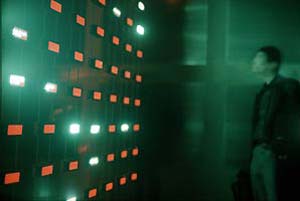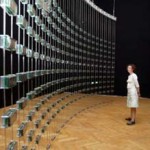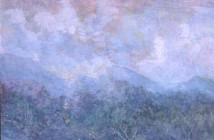So what’s so important about Synthetic Art anyway? Why bother to give it a name? There’s nothing new about artists using the computer, after all…
At this point, in the spirit of full disclosure, Reese states for the record that she has programmed computers for over ten years. In fact, she cherishes her Macintosh G4 – reverently named Minerva – to the extent of dusting Minerva more regularly than anything else in her studio. Karine, au contraire, has never programmed so much as a cappuccino machine, and has every intention of maintaining current lifestyle choices in this regard. Yet Karine’s interest in and support of evolving trends in artmaking prompted this dialogue, which we are opening to our readers...
Computers aren’t new to artists. However, in large part, computer programming is. Herewith, a very brief overview of digital art, focusing on how the accessibility – availability, affordability and ease of adoption – of various computer technologies has been the main driver of their use by artists.
From the mid 50s to mid 80s, a few adventurous folk began experimenting with using the computer to make art. Of necessity, programming was central to their work, since Photoshop et al didn’t yet exist – they had to write their own code. Unsurprisingly, most participants at this point were not primarily artists, and their work received relatively little attention.
By the mid 80s, personal computers had arrived in many homes and most schools. Moving into the early 90s, the desktop publishing revolution gave rise to software such as Photoshop and Premiere, combining with devices such as scanners to attract artists who could now create computer-based or computer-manipulated work without programming.
A few years later in the mid-90s, video recorders were becoming less expensive by the minute. Meanwhile, basic home computers were finally capable of editing and playing back video. CD-ROM drives were getting faster, as were Internet connections, increasingly supporting interactive media that looked good and played smoothly. Significant numbers of artists began using the computer in their work, and digital art started to catch the art world’s imagination. However, programming remained mainly the province of trained professionals and specialists, due to the time commitment involved in acquiring the necessary skills.
Today, programming requires no more time to learn than Photoshop did in the 80s. Programming environments – e.g. Macromedia Director, Flash and Dreamweaver - have evolved into powerful, artist-friendly tools that can be learned basically by playing with them. Loaded with ready-made snippets of code for many basic tasks, they’re designed to accommodate new users and support the learning process; if you make a typo or coding error, the debugger tells you more or less what's gone wrong. This is a far cry from a decade ago, when tracking down minor mistakes often meant hours of frustration.
Alright, you say. So programming is easier than it used to be. Whatever. What’s the big deal?
Firstly, there's a world of difference between the restriction of commercial software vs. the flexibility of being able to write one's own customized programs.
Commercial software is essentially a toolkit of functions designed by a corporation to serve the collective needs of major constituencies such as graphic designers, illustrators and commercial photographers. Artists, on the other hand, tend to have more individual aims. We believe that as programming continues to become more accessible, increasing numbers of artists using the computer in their work will develop their own tools, or – since the democratization of the technology also leads to more programmers in general and thereby more affordable programming services – hire someone else to code for them.
Secondly, in the past, new technologies have often led to new artistic explorations.
A classic example: the arrival of squeeze tube paints in the 1840s made painting a more portable activity and did away with the need for painting mediums. The result? A paradigm shift leading to a period of great innovation. Artists turned to plein air painting without the use of glazing techniques, using relatively opaque paint straight from the tube. Instead of creating form via the juxtaposition of transparency and opacity, they explored a more intensely chromatic palette. Meanwhile, the growing popularity and affordability of another new technology – photography – provided added impetus for painters to differentiate their artistic aims from those purposes which the newer medium was considered to satisfy faster, possibly better, and definitely more cheaply. Impressionism was arguably the most significant shakeup in art history since the Renaissance invention of perspective, and its beginnings are inseparable from the technologies that permitted and fueled the exploration in the first place.
Finally, since the entry of programming has substantially impacted other disciplines, it seems likely that art will be no exception.
Significant numbers of scientists and mathematicians have been programmers for a couple decades at this point. New explorations permitted by harnessing the power of the computer via programming have offered new insights and perspectives on our world, challenging centuries-old paradigms.
For example, the ground-breaking work of scientist/programmer Stephan Wolfram suggests that all processes, from the behavior of the stock market to that of DNA, can be viewed as algorithmic computations, simple instructions repeated ad infinitum. This idea questions three centuries of belief that everything in our world can ultimately be described by mathematical equations. Wolfram's thesis could not have been explored without the computer’s ability to perform massive iterations quickly and accurately. The ability to record and store immense volumes of data has been with us for quite awhile in the form of libraries and archives, but today’s ability to mine the data in search of pattern or structure is unprecedented in human history.
In conclusion, programming is a powerful and increasingly accessible technology offering a plethora of artistic possibilities that we can only begin to imagine. Artists such as Cerith Wyn Evans, Mark Hansen and Ben Rubin, and Jason Salavon are already making fascinating and innovative work synthesizing programming with other media.
The next articles in the series, featuring interviews with curators, will focus on recent exhibitions of synthetic work.
- Mark Hansen & Ben Rubin, Listening Post, electronic components, copper wire, aluminum, loudspeakers, computer software, 2001–02.
Links:
The Synthetic Art Proposition by Karine Jouenne and Reese Inman, Big RED issue #23
Synthetic Art: Genesis by Karine Jouenne and Reese Inman, Big RED issue #24
Synthetic Art: Perspective I by Karine Jouenne and Reese Inman, Big RED issue #25
All images are courtesy of the The Whitney Museum and Ars Electronica.







